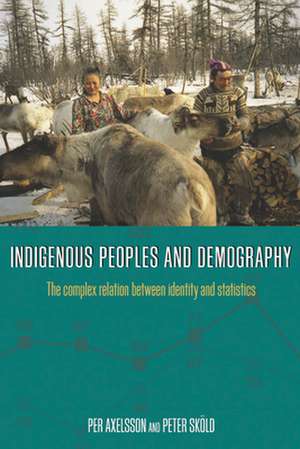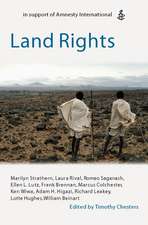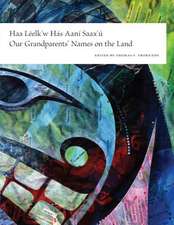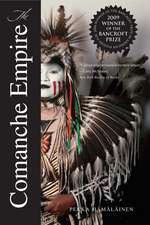Indigenous Peoples and Demography
Editat de Per Axelsson, Peter Skolden Limba Engleză Paperback – 31 oct 2013
Per Axelsson is a Senior Researcher of the Centre for Sami Research at Umeå University, Sweden. His research interests and recent publications focus on indigenous demography, the medical history and historical demography of the Sami and the settlers in northern Sweden during the time of colonization and also the history of polio during the twentieth century. He co-chairs the network of Family/Demography within the European Social Science History Association.
Peter Sköld is Professor of History at Umeå University and Director of the Centre for Sami Research. He is presently working on two major projects concerning the Sami demographic transition and the ageing population. He also directs the Northern Studies program at Umeå University. Recent publications focus on health issues and vulnerability among indigenous peoples (Annales de Démographie Historique and Journal of Circumpolar Health).
| Toate formatele și edițiile | Preț | Express |
|---|---|---|
| Paperback (1) | 265.02 lei 6-8 săpt. | |
| BERGHAHN BOOKS INC – 31 oct 2013 | 265.02 lei 6-8 săpt. | |
| Hardback (1) | 807.61 lei 6-8 săpt. | |
| BERGHAHN BOOKS INC – 31 mar 2011 | 807.61 lei 6-8 săpt. |
Preț: 265.02 lei
Nou
Puncte Express: 398
Preț estimativ în valută:
50.71€ • 52.95$ • 41.88£
50.71€ • 52.95$ • 41.88£
Carte tipărită la comandă
Livrare economică 15-29 aprilie
Preluare comenzi: 021 569.72.76
Specificații
ISBN-13: 9781782383352
ISBN-10: 1782383352
Pagini: 354
Dimensiuni: 152 x 229 x 19 mm
Greutate: 0.47 kg
Editura: BERGHAHN BOOKS INC
ISBN-10: 1782383352
Pagini: 354
Dimensiuni: 152 x 229 x 19 mm
Greutate: 0.47 kg
Editura: BERGHAHN BOOKS INC
Notă biografică
Per Axelsson is a Senior Researcher of the Centre for Sami Research at Umea University, Sweden. His research interests and recent publications focus on indigenous demography, the medical history and historical demography of the Sami and the settlers in northern Sweden during the time of colonization and also the history of polio during the twentieth century. He co-chairs the network of Family/Demography within the European Social Science History Association. Peter Skold is Professor of History at Umea University and Director of the Centre for Sami Research. He is presently working on two major projects concerning the Sami demographic transition and the ageing population. He also directs the Northern Studies program at Umea University. Recent publications focus on health issues and vulnerability among indigenous peoples (Annales de Demographie Historique and Journal of Circumpolar Health).
Cuprins
List of Figures, Maps and, Tables Acknowledgements Introduction Per Axelsson and Peter Skold Chapter 1. Fractional Identities: the Political Arithmetic of Aboriginal Victorians Len Smith, Janet McCalman, Ian Anderson, Sandra Smith, Joanne Evans, Gavan McCarthy and Jane Beer Chapter 2. Building Ethnic Boundaries in New Zealand: Representations of Maori Identity in the Census Tahu Kukutai Chapter 3. Counting Indians: Census Categories in Late Colonial and Early Republican Spanish America Steinar A. Saether Chapter 4. The Construction of Life Tables for the American Indian Population at the Turn of the Twentieth Century J. David Hacker and Michael Haines Chapter 5. The Aboriginal Population and the 1891 Census of Canada Michelle Hamilton and Kris Inwood Chapter 6. 'In the national registry, all people are equal' - Sami in Swedish statistical sources Per Axelsson Chapter 7. The Registers of the 'Sami tax' from 1600 to 1750, and their Usefulness for Reconstructing Population Development and Settlement Lars Ivar Hansen Chapter 8. Viewing Ethnicity From The Perspectives of The Individuals and Households - Finnmark During the Last Part of The Nineteenth Century Hilde L. Jastad Chapter 9.. 'Finn in Flux': 'finn' as a Designation in Norwegian Population Censuses of the Nineteenth and Twentieth Centuries Bjorg Evjen Chapter 10. Testing and Constructing Ethnicity Variables in Late 19th Century Censuses Gunnar Thorvaldsen Chapter 11. Out of the Backwater? Prospects for Contemporary Sami Demography in Norway Torunn Pettersen Chapter 12. Indigenous Household Structure And Economy Among Lake Essei Iakuts 1926/27: The Mystery Of The Magnate Reindeer Herders David G. Anderson Chapter 13. Ethnodemographics and Identity of Indigenous People in the Central Taimyr Lowlands John Ziker Chapter 14. Russian Legal Concepts And Indigenous Peoples Demography Sergey V. Sokolovskiy Chapter 15. Ethnic Identity and Indigenous Populations in the Demographic Sources of the Eastern Baltic Littoral: The Nineteenth and Twentieth Centuries Andrejs Plakans Chapter 16. Who are the British? John MacInnes Epilogue: From Indigenous Demographics to an Indigenous Demography Per Axelsson, Peter Skold, John P. Ziker and David G. Anderson Index










